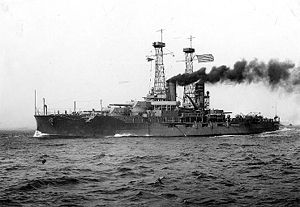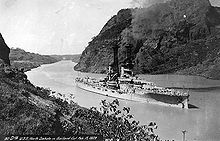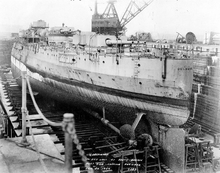- Delaware class battleship
-

USS North Dakota, the second ship of the classClass overview Name: Delaware class battleship Builders: Newport News Shipbuilding
Fore River ShipyardOperators:  United States
United StatesPreceded by: South Carolina class battleship Succeeded by: Florida class battleship Completed: 2 Retired: 2 Preserved: 0 General characteristics [1] Type: Battleship Displacement: Standard: 20,380 tons
Mean War Service: 22,400 tonsLength: 519 ft (158 m) Beam: 85 ft 4 in (26.01 m) Draft: 27 ft 3 in (8.31 m) Propulsion: 25,000 ihp (18,650 kW) Speed: 21 knots (39 km/h) Range: 6,000 nautical miles (11,110 km) at 10 knots
Coal: 1000/2500 tonsComplement: 933 officers and men Armament: - 10 × 12 inch/45 caliber guns
- 14 × 5"/50 caliber gun
- 2 × 21 inch torpedo tubes
Armor: The Delaware-class battleships of the United States Navy were the second class of American dreadnoughts. They carried a battery of ten 12"/45 caliber Mark 5 guns in five turrets, an increase of two guns over the preceding South Carolina class. They were also larger, displacing 25% more than the South Carolinas. The Delawares were capable of 21 knots (40 km/h), a significant improvement over the earlier class, which was limited to 18.5 knots (30 km/h). The two ships of the class, Delaware and North Dakota, were both launched in 1909.
The ships saw varied service during their careers. As part of Battleship Division Nine of the U.S. Atlantic Fleet, Delaware was assigned to the British Grand Fleet after America's entry into World War I, where she escorted convoys and participated in the blockade of the German High Seas Fleet. In contrast, North Dakota remained on the American coast throughout the war, due in part to worries about her troublesome turbine engines. Post-war, they conducted training cruises with the US Atlantic Fleet. In 1924, Delaware was broken up for scrap metal in accordance with the Washington Naval Treaty of 1922. North Dakota survived until 1931, when she too was scrapped, under the terms of the 1930 London Naval Treaty.
Contents
Design
Prompted by the launch of the HMS Dreadnought, and a lack of correct information, the US Navy and the U.S. Congress faced what they thought was a vastly better battleship than the two South Carolina battleships that were still under construction. This was the last time the US Congress would impose tonnage limits on a battleship outside of treaty limitations.[2] In fact the South Carolinas were inferior only in speed to Dreadnought.[3] The language of the authorizing act of June 26, 1906 was for a battleship "carrying as heavy armor and as an powerful armament as any known vessel of its class, to have the highest practicable speed and the greatest practicable radius of action."[4]
The Delaware class was the second of 11 distinct US capital ship designs begun from 1906 to 1919. Some 29 battleships and six battlecruisers were laid down during this period, though seven of the battleships and all six of the battlecruisers were cancelled. Except for the Lexington-class battlecruisers, these were all relatively slow ships, designed for no more than 23 knots. They ranged in displacement from 16,000 to 42,000 tons.[5] At this time no U.S. dreadnought class battleship had yet hit the water as all were either at some stage of building or in design. Virtually the entire U.S. Navy battle line was being designed by drawing on experience from pre-dreadnought designs or from observation of foreign battleship design.[6]
General characteristics
The Delawares were significantly more powerful than their predecessors, the South Carolina class; the only limit Congress placed on the battleship's design was in the fact that the hull and machinery could not exceed 6 Million USD.[4]The Delaware class ships were also significantly larger than the South Carolinas. They were 510 ft (155.5 m) long at the waterline and 519 ft (158.2 m) long overall. By comparison, the South Carolina class ships were 452 ft 9 in (138 m) long overall. The Delawares had a beam of 85 ft 4 in (26 m) and a draft of 27 ft 3 in (8.3 m); the South Carolinas measurements were 80 ft 5 in (24.5 m) and 24 ft 7 in (7.5 m), respectively.[7] The Delaware class ships displaced 20,380 tons at standard displacement and 22,060 tons at full load.[8]
Machinery
For reasons including expected hostilities with Japan, requiring travel across the Pacific Ocean, long operational range was a recurrent theme in all US battleship designs.[9] As an experiment, these ships received different powerplants. Delaware received triple-expansion reciprocating engines, while North Dakota was fitted with Curtiss direct drive steam turbine engines. Both ships had 14 Babcock & Wilcox boilers, both original power plants were rated at 25,000 nbsp, shaft horsepower;[8] and both ships were capable of reaching 21 knots.[10]
However, the turbine engines in the North Dakota failed to meet Navy fuel consumption standards.[10] At a cruising speed of 14 knots the ship had 45% less range than the Delaware'.[8] By 1915 more powerful and efficient geared turbines were installed. These provided 31,300 shaft horsepower, some 6,000 shp greater than her original engines.[10] [11] rated at 31,000 shaft horsepower.[11]
Armament
 The three aft 12 inch gun turrets on Delaware
The three aft 12 inch gun turrets on Delaware
The Delaware class ships were armed with ten 12 in (30 cm) 45-caliber guns in five twin gun turrets; this was an addition of two guns compared to the preceding South Carolinas. Two turrets were mounted fore in a superfiring pair, while the other three were mounted aft of the main superstructure, all on the centerline. The two rearmost turrets were emplaced on the main deck, facing forward and rearward, while the center turret was placed in a superfiring position, facing rearward.[10] The gun housings were the Mark 8 type, and they allowed for depression to −5 degrees and elevation to 15 degrees. The guns had a rate of fire of 2 to 3 rounds per minute. They fired 870 lb (394.6 kg) shells, of either armor-piercing (AP) or Common types, though the Common type was obsolete by 1915 and put out of production. The propellant charge was 310 lb (140.6 kg) in silk bags, and provided a muzzle velocity of 2,700 fps (823 mps). The guns were expected to fire 175 rounds before the barrels would require replacement. The two ships carried 100 shells per gun, or 1,000 rounds in total. At 15 degrees elevation, the guns could hit targets out to approximately 20,000 yards (18,290 m).[12]
The primary anti-destroyer armament was a battery of 5-inch /50 caliber naval cannons mounted in casemates. The guns had a rate of fire of 6 to 8 rounds per minute. They fired three types of rounds: a "light" AP shell that weighed 50 lb (22.7 kg) and a "heavy" AP round that weighed 60 lb (27.2 kg). The third type was the Common Mark 15 shell, which also weighed 50 lb. The 50 lb shells were fired at a muzzle velocity of 3,000 fps (914 mps), while the larger 60 lb shells traveled at a slightly slower 2,700 fps (823 mps). The guns were emplaced on both Mark 9 and Mark 12 pedestal mounts; the Mark 9 version limited elevation to 15 degrees, while the Mark 12 allowed for up to 25 degrees.[13] The 5"/50 was able to penetrate most effectively at 5,000 yards (5,000 m), which was the deciding factor in the decision to equip the Delaware class with them.[2] Fourteen 5"/50 guns were mounted 2 forward on the main deck, 10 in casemates on the side and 2 aft on the main deck abeam #5 turret, the forward guns were moved into the superstructure after sea trials.[2] The casemate-mounted secondary armament was one deck below the main deck and provided the majority of the complaints from shipping water from the forward positions and breaking the flow of the bow wave imparting extra drag on the design.[2] The 5 in guns were supplied with a total of 240 rounds per barrel.[13]
Armor
The armored belt ranged in thickness from 9 inches (228 mm) to 11 in (280 mm) in the more important areas of the ship. Casemated guns mounted in the hull had between 8–10 inches of armor plate (203–254 mm).The barbettes that housed the main gun turrets were armored with between 4–10 in (102–254 mm) of armor; the side portions more vulnerable to shell fire were thicker, while the front and rear sections of the barbette, which were less likely to be hit, received thinner armor to save weight. The gun turrets themselves were armored with 12 in (305 mm) of armor. The conning tower was 11.5 in (292 mm) thick.[8] As in the designs of all early dreadnoughts, the deck armor was very thin at 1.5 inches in most areas and 2 inches over machinery and magazine spaces. These ships were expected to do most of their firing at ranges less than 10,000 yards (10,000 m). At such distances, deck strikes would be a rare event.[14]
Service history
USS Delaware
Main article: USS Delaware (BB-28)During trials, Delaware was run at full speed for 24 hours straight to prove that her machinery could handle the stress. She was the first American battleship to achieve the feat.[8] Late in 1910, Delaware sailed to Europe, followed by a trip to South America early in 1911. She made a further two voyages to Europe in 1912 and 1913, before returning to the US Atlantic Fleet for training exercises that were conducted in the western Atlantic and Caribbean. Delaware took part in the Second battle of Vera Cruz in April–May 1914.[15]
When the United States declared war on Germany in April 1917, Delaware was initially tasked with readiness training off the East Coast.[15] Late in the year, she was deployed to Europe as part of the US Navy's Battleship Division Nine, under the command of Rear Admiral Hugh Rodman. The force arrived on 7 December and was assigned to the 6th Battle Squadron of the Grand Fleet.[16] In July 1918, Delaware was withdrawn from overseas service and returned to the United States.[15]
In 1920, the US Navy adopted hull numbers for its ships; Delaware was assigned the hull number BB-28. Delaware only made two more cruises, both for midshipmen, under her new identification number: one in 1922 and the second in early 1923. Delaware sailed to Europe on the second trip, and stopped at a number of ports, including Gibraltar. She returned to the US in August of that year, at which point her crew was reassigned to the newer battleship Colorado. She was then taken to the Boston Navy Yard, where her armaments were removed. The ship was decommissioned in November 1923 and sold to shipbreakers in February 1924.[15]
USS North Dakota
Main article: USS North Dakota (BB-29) North Dakota transiting the Panama Canal
North Dakota transiting the Panama Canal
Upon commissioning, the ship was assigned to the Atlantic Fleet, alongside her sister Delaware. Her first overseas cruise came in November 1910, when she steamed across the Atlantic to visit France and Britain. North Dakota also took part in the invasion of Vera Cruz in 1914. Unlike her sister, North Dakota remained off the American coast for the duration of the United States' involvement in World War I.[17] Hugh Rodman, the commander of the American expeditionary force, specifically requested that North Dakota be kept stateside; he felt her turbine engines were too unreliable for the ship to be deployed to a war zone.[18]
From 1917, she was employed as a training ship for gunners and engineers. Post-war, North Dakota made a second trip to Europe, primarily to ports in the Mediterranean Sea. During the visit, the ship was tasked with the retrieval of the remains of the ambassador to Italy, who had recently died. The ship participated in the aerial bombing demonstrations off the Virginia Capes in 1921. In 1923, a third trip to Europe, this time with midshipmen from the Naval Academy aboard. The ship stopped in Spain, Scotland, and Scandinavia.[17]
Like her sister, she was relegated to the surplus naval forces that had to be dismantled under the Washington Naval Treaty. In November 1923, North Dakota was decommissioned; she had her armaments removed in 1924, after which she was converted into a target ship. She was redesignated as "unclassified", and served as a target until 1931, when she was scrapped.[17]
Footnotes
- ^ Conway, 1985, p.113
- ^ a b c d Friedman, p. 65
- ^ Friedman, p. 64
- ^ a b Friedman, p. 63
- ^ http://www.ibiblio.org/hyperwar/OnlineLibrary/photos/usnshtp/bb/bb.htm
- ^ Friedman, Norman. U.S. Battleships: An Illustrated Design History ISBN 0-87021-715-1 P96
- ^ Gardiner and Gray, pp. 112–113
- ^ a b c d e Gardiner and Gray, p. 113
- ^ Friedman, p. 69
- ^ a b c d Hore, p. 57
- ^ a b "Delaware Class (BB-28 and BB-29), 1907 and 1908 Building Programs". USN Historical Center. 30 January 2001. http://www.history.navy.mil/photos/usnshtp/bb/bb28cl.htm. Retrieved 11 August 2009.
- ^ Friedman, p. 101
- ^ a b c d "USS Delaware (Battleship # 28, later BB-28), 1910-1924". USN Historical Center. 30 January 2001. http://www.history.navy.mil/photos/sh-usn/usnsh-d/bb28.htm. Retrieved 12 August 2009.
- ^ Halpern, p. 404
- ^ a b c "USS North Dakota (Battleship # 29, later BB-29), 1910-1931". USN Historical Center. 16 January 2001. http://www.history.navy.mil/photos/sh-usn/usnsh-n/bb29.htm. Retrieved 12 August 2009.
- ^ Jones, p. 40
References
- Friedman, Norman (1986). U.S. Battleships: An Illustrated Design History. Annapolis: Naval Institute Press. ISBN 0870-2-1715-1. http://books.google.com/books?id=Y41Ha_3HsrYC.
- Gardiner, Robert; Gray, Randal, eds (1984). Conway's All the World's Fighting Ships: 1906–1922. Annapolis: Naval Institute Press. ISBN 0870219073.
- Halpern, Paul G. (1995). A Naval History of World War I. Annapolis: Naval Institute Press. ISBN 1557503524.
- Hore, Peter (2006). Battleships of World War I. London: Southwater Books. ISBN 978-1-84476-377-1.
- Jones, Jerry W. (1998). U.S. Battleship Operations in World War I. Annapolis: Naval Institute Press. ISBN 9781557504111.
- Conway's All the world's fighting ships 1906-1921. Annapolis, Maryland: Naval Institute Press. 1985. ISBN 0-87021-907-3.
External links
Delaware-class battleship- Preceded by: South Carolina class
- Followed by: Florida class
United States naval ship classes of World War IDreadnought battleships - South Carolina
- Delaware
- Florida
- Wyoming
- New York
- Nevada
- Pennsylvania
- New Mexico
- Tennessee C
- Colorado C
- South Dakota X
Pre-dreadnought battleships Battlecruisers Armored cruisers Light cruisers Protected cruisers - Chicago S
- Baltimore S
- San Francisco S
- Olympia S
- Cincinnati S
- Raleigh S
- Montgomery S
- Marblehead S
- Columbia
- New Orleans
- Denver
- St. Louis
Destroyers Submarines Auxiliaries - Recruit S
- S — Single ship of class
- C — Completed after the war
- X — Cancelled
Categories:- Battleship classes
- Delaware class battleships
- World War I battleships of the United States
Wikimedia Foundation. 2010.

